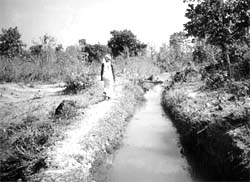Together they conquered
 this is a story of human solidarity and struggle for survival in the face of all odds. It is also a story of an individual's endeavours succeeding long after he is gone. And it took 15 years for his efforts to bear fruit in the small village of Ashrubahal in the Angul district of Orissa.
this is a story of human solidarity and struggle for survival in the face of all odds. It is also a story of an individual's endeavours succeeding long after he is gone. And it took 15 years for his efforts to bear fruit in the small village of Ashrubahal in the Angul district of Orissa.
The tribal community of Ashrubahal was at one time mainly dependent on the forests for their livelihood. This dependence on forest products was aggravated by the fact that land for agriculture was scarce and irrigation facilities non-existent. Therefore, the villagers turned to forest products like wood, fodder and fruits for their subsistence. Needless to say, they also resorted to massive felling of trees. Degradation of the environment heralded a whole lot of problems like soil erosion and shortage of groundwater.
Suffering from acute poverty and illiteracy, the community would have faced a hopeless situation had it not been for the unique effort made by the village committee under the leadership of Giridhari Dehuri.
Dehuri took the lead and 15 years back initiated the village committee to divert the rainwater from a perennial nalah (stream) to agricultural lands in and around the village. The Anlaghai stream ran through the Madhupur forests, nearly 4 km away from Ashrubahal, and diverting its waters back has today led to prosperity in the village.
Once the decision to divert the waters of the stream was taken by the committee, villagers chipped in to provide voluntary labour services, also called shramadan . Later on, the Youth Association for Rural Reconstruction (yarr), a local non-governmental organisation (ngo ), gave the village Rs 30,000 to construct a check dam to channel the water from the stream into the farmland. As the villagers worked for a good cause the government did not intervene and there were no legal hassles in diverting the course of the stream.
Water from the stream has helped the farmers to cultivate crops twice a year, which was earlier not possible. Today, the village scenario is far removed from the despondency it presented in the past. The villagers can now irrigate over 30 hectares of land and lush green fields stretched across 40-50 hectares is no longer a rare sight. Livelihood is obtained not from the forests but agricultural products.
With the focus shifting to agriculture, the forests have now rejuvenated and the trees have increased considerably in number. The villagers have also established a Village Forest Committee to preserve and protect the neighbouring forests.
With improved economic status, villagers are now paying attention to education and can afford to send their children to schools. Moreover, adults have now stopped migrating outside the village to earn their living. "We have realised the importance of community participation in the development process. Now we are trying to improve our status on our own," says Tapan Kumar Sahoo, a member of the village committee.
With increase in literacy rates,villagers have now become aware of their rights and have knowledge on diverse issues pertaining to the development of the village. Even the women have ventured out of their homes and now take part in the various activities of the village and also attend the meetings of the village committee.
Meanwhile, the village committee has already started making plans to divert the waters of yet another stream and they have submitted a petition to the government regarding this. However, optimism runs high among the local people. Karno Behra, 35, a villager from Ashrubahal reflects this confidence when she says: "Whether the government helps us or not, we are capable of bringing about changes in our village without any external support."
So far, although there has been no opposition from the government for the developmental activities undertaken by the villagers, the forest officials have posed hurdles in their path because they do not want the villagers to manage the forests on their own.
